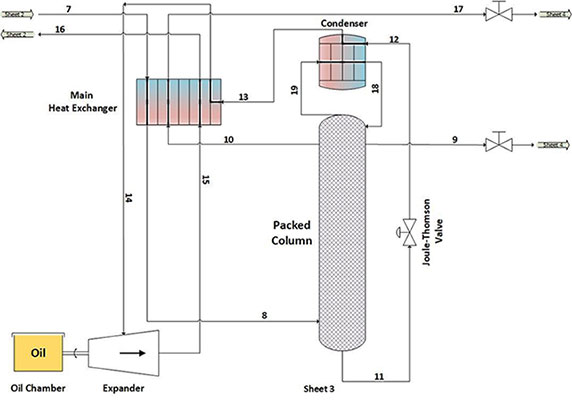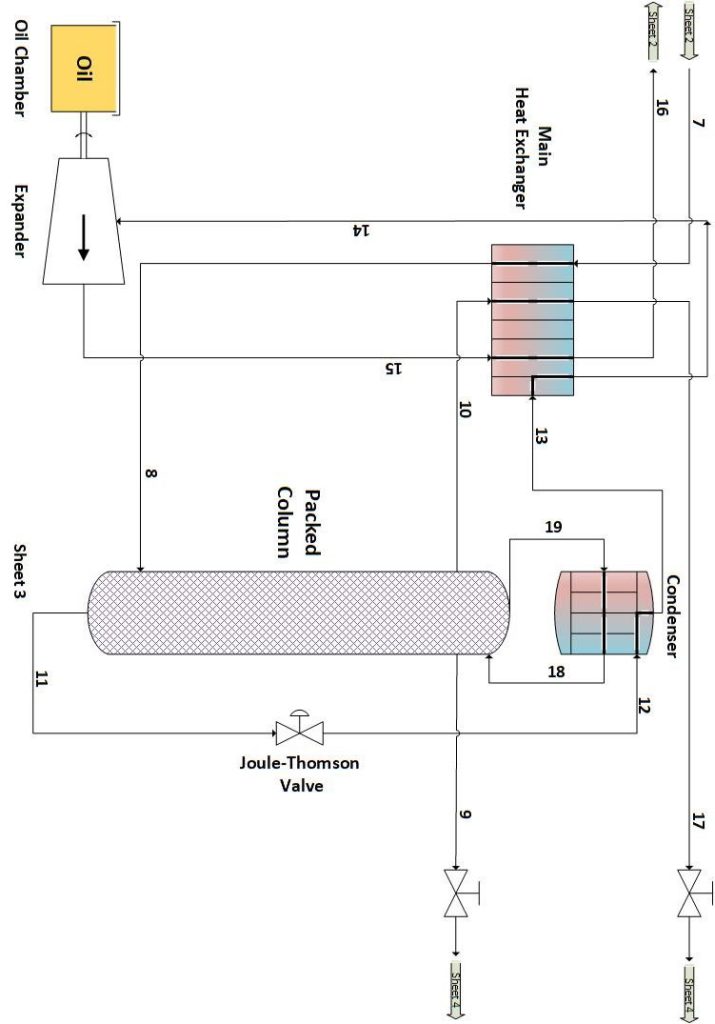Air Separation is known as a process in which the air components are separated from each other. Therefore, according to its main constituent elements, atmospheric air can be considered as a suitable source for the industrial production of nitrogen, oxygen, argon and other rare gases.
Although non-refrigerated methods such as adsorption, chemical process, and membrane systems are applicable in air separation plants; But the cryogenic method has widely attracted attentions to employ for producing oxygen, nitrogen and argon in high flow rates and purities.
Cryogenic process
The term cryogenics generally refers to a field of science and technology that deals with very low temperatures. Air separation by cryogenic method is a process that is established to produce high purity nitrogen, oxygen, argon and… in liquid and gaseous forms. Air separation units, depending on the need, have the capability of poly-generation such as nitrogen, oxygen and argon. As the number of required components in air separation units increases, the number of implemented towers to separate the components also enhances. Nitrogen production units have a distillation tower which is of Rectifier type. These types of towers do not have a reboiler. The feed enters the tower in the form of saturated vapor from the bottom, and pure nitrogen also in the form of saturated vapor leaves the tower from the Nozzle located at the top of the tower. Oxygen production and argon production units have two and four distillation towers, respectively. Due to the extremely low temperature range of the air separation units, the main equipment (such as tower, main heat exchanger, condenser, expander and etc.) are placed into a fully insulated enclosure to prevent heat loss. This chamber is known as cold box. The figure below depicts a schematic of an air separation unit designed solely for nitrogen production.


In cryogenic units, by exergy extraction from the fluid (in the form of mechanical work) and expansion process, the temperature of the fluid diminishes so that liquefaction occurs. In the mentioned process, a Turbo-Expander is applied to extract work and reduce the temperature of the entire process.
Liquid nitrogen, oxygen and argon storage tanks
After producing liquefied gas through cryogenic method, it is vital to store it under certain conditions so that it can be exploited when needed. Liquid nitrogen, oxygen, and argon storage tanks are known as cryogenic tanks, which have the ability to store these liquids at very low temperatures. These pressure vessels have a double-walled structure in them the gap between two walls is completely insulated with very high thermal resistance. In addition, the middle gap has a relative vacuum, which leads to the minimum heat transfer from inner vessel to the surroundings. These storage tanks can be manufactured with the capacity of up to 300 cubic meters.
Vaporizers
In addition to the mentioned equipment, in order to convert liquid nitrogen into gaseous form, an equipment called vaporizer is employed. By heating liquid nitrogen, this equipment turns it into gas and prepare it for delivery to different units. Evaporators are classified into different categories depending on the type of heat source deal with. If the ambient air plays a role of heat source, the heat transfers from this medium to liquid nitrogen or oxygen and turns the fluid to gas. These types of evaporators are so called atmospheric evaporators. Another type of vaporizers are steam type which delivers the steam heat to the cryogenic liquid with the aim of vaporizing and gas temperature enhancement. These types of vaporizers are known as steam vaporizers which have the capability of temperature increment of gaseous nitrogen even higher than the ambient temperature.
Cryogenic method specifications
Nitrogen and other gases production through the cryogenic method has specific characteristics which have made this method widely used and popular in various industries. Some of the main features of this method can be listed as follows:
High purity: the generated nitrogen and other gases through cryogenic method have high purity. This feature is very important because in industries such as electronics, pharmaceutical, oil and gas, and food the necessity of high purity gases is completely obvious.
Precise control: The cryogenic method has the ability of controlling the production of nitrogen and other gases meticulously. This possibility helps the industries to adjust the production rate by the system that respond to their needs quickly.
Cost savings: Cryogenic method can be regarded affordable. Compared to other methods such as fractional distillation or membrane absorption, this method is less expensive, which helps industries to reduce production costs.
Safety and sustainability: The cryogenic method is known as a safe and sustainable method due to the lack of use of dangerous chemicals and complex processes. Also, this method is environmentally friendly that has less effects on the atmosphere compared to the other ways.
Wide applications: Nitrogen and other gases produced by cryogenic method are used in various industries such as metal, oil, gas and petrochemical, electronics, food, pharmaceutical and lithography industries. Nitrogen as a neutral gas plays an important role in many industrial processes. These features results in the cryogenic method is known as one of the prominent and effective methods in the production of nitrogen and other gases in various industries.
Through gathering a team consists of experts in the design, engineering and construction of cryogenic units under the license of reputable brands, HAVAYAR industrial group is able to design, manufacture and supply different air separation units to produce nitrogen, oxygen and argon with different purities.
